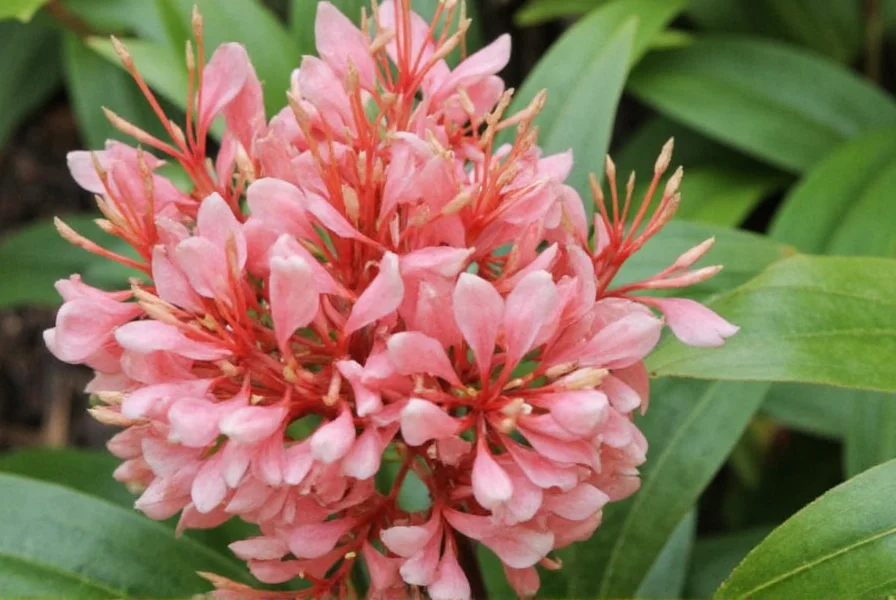Torch ginger, scientifically classified as Etlingera elatior, represents one of the most visually striking members of the ginger family. This perennial plant grows up to 4-5 meters tall in ideal conditions, producing spectacular cone-shaped flower buds that transition from deep pink to vibrant red as they mature. Indigenous to Malaysia, Indonesia, and the Philippines, torch ginger has become an integral component of Southeast Asian culinary traditions and cultural practices.
Botanical Characteristics and Identification
Understanding how to identify torch ginger begins with recognizing its distinctive features. The plant produces pseudostems formed from tightly wrapped leaf sheaths, reaching heights of 3-5 meters. Its most recognizable feature is the inflorescence—a large, cone-shaped structure emerging horizontally from the base of the plant. These flower buds measure 10-15 cm in length and display brilliant pink to crimson hues.
Unlike common ginger which is cultivated primarily for its rhizomes, torch ginger's culinary value comes from its flower buds, young shoots, and immature fruits. The flower buds contain a crisp texture with a flavor profile combining citrus, rose, and subtle spiciness—making them valuable in regional cuisines.
Habitat and Cultivation Requirements
Torch ginger thrives in USDA hardiness zones 10-12, requiring specific environmental conditions for optimal growth:
| Growth Requirement | Optimal Conditions | Tolerance Range |
|---|---|---|
| Temperature | 25-32°C (77-90°F) | 15-40°C (59-104°F) |
| Soil Type | Rich, well-draining loam | Clay to sandy soils with organic matter |
| Water Needs | Consistently moist | High humidity environments |
| Sun Exposure | Partial shade | Filtered sunlight to full shade |
Gardeners interested in growing torch ginger should plant rhizomes 5-10 cm deep in nutrient-rich soil with ample organic matter. The plants require protection from strong winds and direct afternoon sun. Propagation occurs through division of established clumps during the rainy season. While torch ginger can tolerate brief periods of drought, consistent moisture produces the highest quality flower buds.
Culinary Applications Across Southeast Asia
The culinary uses of torch ginger demonstrate remarkable regional diversity throughout its native range. In Malaysian cuisine, the flower buds (known as bunga kantan) feature prominently in asam laksa, a sour fish noodle soup where they provide both visual appeal and distinctive flavor. Indonesian cooking incorporates young shoots into gado-gado (vegetable salad with peanut sauce), while Filipino chefs use the flower buds to add complexity to seafood stews.
When preparing torch ginger for culinary use, chefs typically remove the tough outer layers to access the tender inner portions. The flavor profile combines citrus notes with subtle spiciness and floral undertones—making it an excellent complement to fish, chicken, and vegetable dishes. For those exploring traditional Southeast Asian recipes, understanding how to select and prepare fresh torch ginger significantly enhances authentic cooking experiences.
Traditional Medicinal Applications
Various Southeast Asian cultures have incorporated torch ginger into traditional healing practices for generations. Malaysian folk medicine utilizes flower bud extracts to address digestive discomfort and respiratory issues. In the Philippines, practitioners have historically prepared leaf infusions to reduce inflammation and support wound healing.
Scientific research has begun investigating these traditional applications. Studies published in the Journal of Ethnopharmacology indicate that torch ginger contains bioactive compounds with potential antioxidant properties. However, current research remains preliminary, and no medical claims should be made regarding its efficacy for treating specific health conditions. Those interested in traditional medicinal uses of torch ginger should consult healthcare professionals before incorporating it into wellness routines.
Distinguishing Torch Ginger from Common Ginger Varieties
Many people confuse torch ginger with common ginger (Zingiber officinale), but significant botanical and culinary differences exist between these plants:
- Plant structure: Torch ginger produces spectacular flower buds while common ginger develops underground rhizomes
- Primary edible component: Torch ginger's value comes from flower buds and shoots; common ginger centers on rhizomes
- Flavor profile: Torch ginger offers citrus-floral notes; common ginger delivers sharper, more pungent heat
- Culinary applications: Torch ginger typically serves as garnish or subtle flavoring; common ginger functions as primary spice
Understanding these differences proves essential when following authentic Southeast Asian recipes that specifically call for torch ginger. Substituting common ginger typically results in significantly altered flavor profiles that don't capture the intended culinary experience.
Cultural Significance in Native Regions
Beyond its practical applications, torch ginger holds deep cultural significance throughout Southeast Asia. In Malaysia, the flower buds frequently appear in traditional wedding ceremonies as symbols of prosperity and beauty. Indonesian communities incorporate the vibrant blooms into religious offerings and decorative arrangements for important festivals.
The plant's visual appeal has also inspired artistic representations across the region. Traditional textiles, pottery, and architectural elements frequently feature torch ginger motifs, reflecting its importance in local aesthetics. For travelers exploring Southeast Asia, recognizing torch ginger in markets and landscapes provides valuable insight into regional cultural practices.

Harvesting and Storage Techniques
Proper harvesting and storage significantly impact the quality and shelf life of torch ginger. Harvesters typically select flower buds when they reach 8-12 cm in length and display vibrant coloration but remain tightly closed. The optimal harvesting time occurs early in the morning when temperatures are cooler.
For maximum freshness, store harvested torch ginger buds in perforated plastic bags within the refrigerator's high-humidity drawer. Under these conditions, they maintain quality for 7-10 days. Some chefs recommend wrapping the base of the buds in damp paper towels to extend freshness. Freezing torch ginger is generally not recommended as it compromises the delicate texture.
Environmental Benefits and Ecosystem Role
Torch ginger contributes significantly to tropical ecosystem health. Its dense growth pattern provides valuable habitat for small birds and insects. The plant's extensive root system helps prevent soil erosion on slopes and riverbanks—making it particularly valuable in regions prone to heavy rainfall.
When incorporated into permaculture designs, torch ginger serves as an effective companion plant. Its large leaves create beneficial shade for more delicate understory species while attracting pollinators with its showy flowers. Sustainable cultivation practices emphasize maintaining biodiversity by planting torch ginger alongside other native species rather than in monocultures.
What's the difference between torch ginger and common ginger?
Torch ginger (Etlingera elatior) and common ginger (Zingiber officinale) belong to the same botanical family but differ significantly. Torch ginger produces showy pink to red flower buds as its primary edible component, while common ginger is cultivated for its underground rhizomes. Torch ginger offers citrus-floral notes in cooking, whereas common ginger delivers sharper, more pungent heat. The plants also differ in growth habit—torch ginger grows taller with prominent flowers, while common ginger remains shorter with less conspicuous blooms.
Can you grow torch ginger outside tropical climates?
Growing torch ginger outside tropical climates presents challenges but is possible with proper care. In USDA zones 8-9, it may survive as a seasonal plant but requires winter protection. Container cultivation allows gardeners in temperate regions to bring plants indoors during cold months. Key requirements include maintaining high humidity (60%+), providing filtered sunlight, and ensuring consistently warm temperatures (25-32°C/77-90°F). Without these conditions, the plant typically fails to produce quality flower buds.
How do you prepare torch ginger for cooking?
To prepare torch ginger for culinary use, first select firm, brightly colored flower buds without blemishes. Peel away the tough outer layers until reaching the tender pink interior. Slice the remaining portion thinly crosswise for salads or soups, or leave whole for garnishing dishes. The young shoots can be sliced similarly to lemongrass. Due to its delicate flavor, add torch ginger near the end of cooking to preserve its distinctive citrus-floral notes. Avoid overcooking, which diminishes both flavor and visual appeal.
Where can you find authentic torch ginger outside Southeast Asia?
Authentic torch ginger is increasingly available outside Southeast Asia through specialty Asian markets, particularly those focusing on Malaysian, Indonesian, or Filipino products. Larger metropolitan areas often feature it in the fresh produce section of international grocery stores. Online specialty produce retailers now offer shipping options, though quality may vary. When fresh torch ginger isn't available, some recipes accept frozen buds as a substitute, though texture differences exist. Always verify you're purchasing Etlingera elatior, as some markets incorrectly label other ginger varieties as torch ginger.











 浙公网安备
33010002000092号
浙公网安备
33010002000092号 浙B2-20120091-4
浙B2-20120091-4